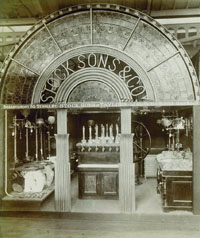News
Bringing the world to Birmingham in 1886: An exhibition about an exhibition

A new, temporary, exhibition in Birmingham's Centenary Square, Broad Street, from 20 June until 31 August 2009, entitled 'Made in Birmingham: The Exhibition of Local Manufactures and Natural History 1886', will celebrate one of the most important public demonstrations of Birmingham’s commercial and industrial prowess in the 19th century, with the help of fifty images drawn from a commemorative album held in the collections at Birmingham Central Library. With the help of other related historical material, the exhibition offers visitors a unique opportunity to explore the spectacular shop window which the 1886 exhibition provided to over 400,000 visitors, who were able to see a huge variety of goods ― ranging from heavy engineering and machinery to furniture, and decorative and domestic wares ― made and sold in Birmingham during the late 19th century.

Stock Sons & Co, Exhibition of Local Manufacturers and Natural History, Bingley Hall, Birmingham, 1886. Photograph: Birmingham Library and Archives Services.
The exhibition is part of a series of events being staged to mark the bicentenary of the death of Matthew Boulton (1728–1809) (www.matthewboulton2009.org), the pioneering Birmingham manufacturer and industrialist whose revolutionary ideas helped to define the West Midlands region. During the 18th century Boulton created the Soho Manufactory, in its day the most famous factory in the world. It housed not only workshops, but also showrooms, design offices, stores and workers' accommodation. Boulton built his reputation on the manufacture of top quality jewellery, silverware and plated goods. In 1774 he went into business with the inventor James Watt and together they built and marketed Watt's steam engines.

Swinden & Co, Watchmakers, Exhibition of Local Manufacturers and Natural History, Bingley Hall, Birmingham 1886. Photograph: Birmingham Library and Archives Services.
Pete James, Head of Photographs at Birmingham Central Library, contacted Local History Online to tell us about 'Made in Birmingham' and our small part in its creation: 'During the course of my research I drew extensively on the research, published on your website, that Bill Ainsworth undertook on the Bingley Hall. I knew Bill, not as well as others, but he was always very warm, helpful and supportive of the work I was doing. I have therefore put a small dedication into the brochure to acknowledge my debt to Bill's research.' Bill died at the end of 2008, aged 93, knowing that his book, Bingley Hall (www.local-history.co.uk/bh/), had made into onto the web, where it could reach a wider audience. Little did Bill, or us, realise just how soon his work would be acknowledged and contribute to a exhibition which has his beloved Bingley Hall at its heart. Both have gone, but neither are forgotten.
'Made in Birmingham: The Exhibition of Local Manufactures and Natural History 1886', a temporary exhibition in Birmingham's Centenary Square, Broad Street, 20 June–31 August 2009, admission free. The exhibition is accompanied by a special 24pp brochure available from Birmingham Central Library and Birmingham Museum and Art Gallery Shop.
15 June 2009

